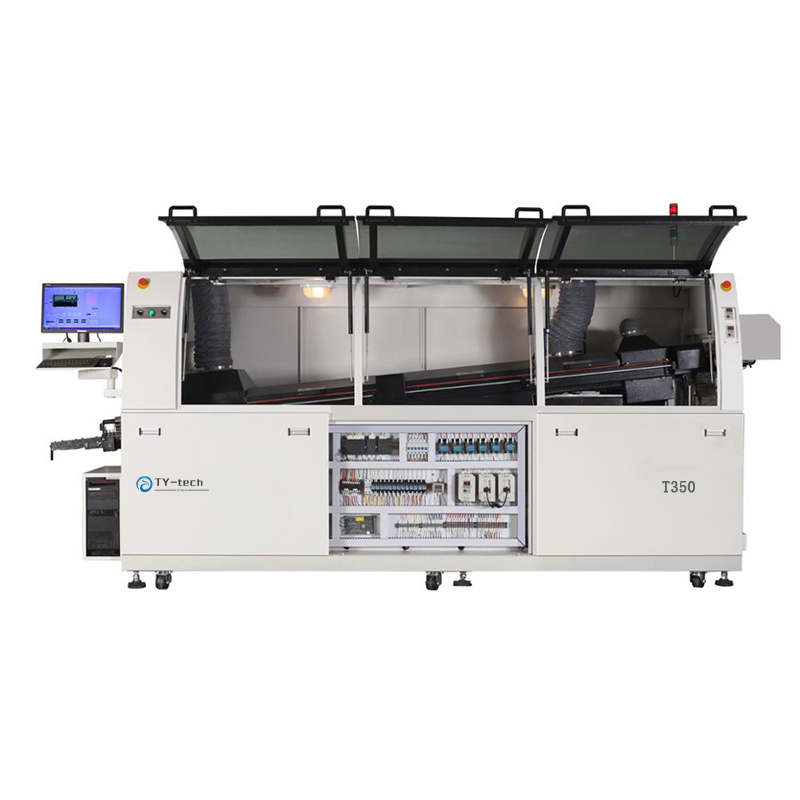1. Operation steps of wave soldering machine.
1). Wave soldering equipment preparation before welding
Check whether the PCB to be soldered is damp, whether the solder joints are oxidized, deformed, etc.; the flux is connected to the nozzle interface of the sprayer.
2). Start-up of wave soldering equipment
Adjust the width of the wave soldering machine drive belt (or fixture) according to the width of the printed circuit board; turn on the power and function of each fan of the wave soldering machine.
3). Set the welding parameters of the wave soldering equipment
Flux Flow: Depending on how the flux contacts the bottom of the PCB. The flux is required to be evenly coated on the bottom of the PCB. Starting from the through hole on the PCB, there should be a small amount of flux on the surface of the through hole penetrating from the through hole to the pad, but not penetrating
Preheating temperature: set according to the actual situation of the microwave oven preheating zone (the actual temperature on the upper surface of the PCB is generally 90-130°C, the temperature of the thick plate is the upper limit for the assembled board with more SMD components, and the temperature rise slope is less than or equal to 2°C/S;
Conveyor belt speed: according to different wave soldering machines and PCB settings to be soldered (generally 0.8-1.60m/min); solder temperature: (must be the actual peak temperature displayed on the instrument (SN-Ag-Cu 260±5℃ , SN-Cu 265±5°C). Since the temperature sensor is in the tin bath, the temperature of the meter or LCD is about 3°C higher than the actual peak temperature;
Peak height measurement: when it exceeds the bottom of the PCB, adjust to 1/2~2/3 of the PCB thickness;
Welding angle: transmission inclination: 4.5-5.5°; welding time: generally 3-4 seconds.
4). The product should be wave soldered and inspected (after all welding parameters reach the set value)
Gently place the printed circuit board on the conveyor belt (or fixture), the machine automatically sprays rib flux, preheats, wave solders and cools; the printed circuit board is connected at the exit of the wave soldering; according to the factory inspection standard.
5). Adjust welding parameters according to PCB welding results
6). Carry out continuous welding production, connect the printed circuit board at the outlet of wave soldering, put it into the anti-static turnover box after inspection, and send the maintenance board for subsequent processing; during the continuous welding process, each printed board should be inspected, and the welding defects Severe printed boards should be re-soldered immediately. If there are still defects after welding, the cause should be found out, and the welding should be continued after adjusting the process parameters.
2. Points for attention in wave soldering operation.
1). Before wave soldering, check the operation status of the equipment, the quality of the printed circuit board to be soldered and the plug-in status.
2). In the process of wave soldering, you should always pay attention to the operation of the equipment, clean up the oxides on the surface of the tin bath in time, add polyphenylene ether or sesame oil and other antioxidants, and replenish the solder in time.
3). After wave soldering, the welding quality should be checked block by block. For a small number of missing soldering and bridging soldering points, manual repair welding should be carried out in time. If there are a large number of welding quality problems, find out the reasons in time.
Wave soldering is a mature industrial soldering technique. However, with the large number of applications of surface mount components, the mixed assembly process of plug-in components and surface mount components assembled on the circuit board at the same time has become a common assembly form in electronic products, thus providing more process parameters for wave soldering technology. In order to meet the strict requirements, people are still constantly exploring ways to improve the soldering quality of wave soldering, including: strengthening the quality control of printed circuit board design and components before soldering; improving the process materials such as flux and solder Quality control; during the welding process, optimize the process parameters such as preheating temperature, welding track inclination, wave height, welding temperature and so on.
Post time: Jun-08-2023





